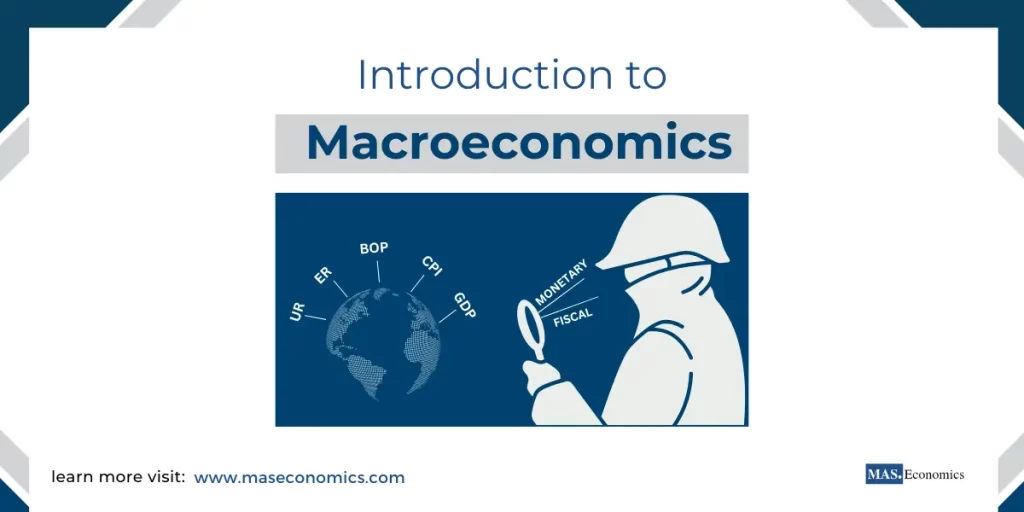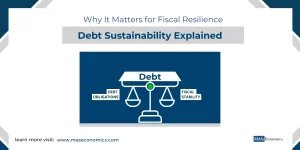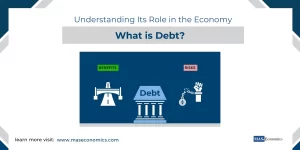Macroeconomics is a field that examines the bigger picture of an economy—whether national or global. Imagine zooming out from the individual choices of consumers and businesses to take in all the pieces that make an economy tick. Macroeconomics does just that. It studies aggregate indicators like GDP, inflation, unemployment, and trade balances to understand how they shape economic outcomes.
Governments, businesses, and central banks rely on macroeconomic analysis to make important policy decisions that foster stability, growth, and prosperity. Unlike microeconomics, which focuses on individual markets, macroeconomics helps us answer big questions: What causes economic growth? Why do recessions occur? How can we control inflation? Understanding these concepts allows governments worldwide to steer challenges and create opportunities for a more stable economy.
The Purpose and Scope of Macroeconomics
Macroeconomics’ primary purpose is to provide a framework for understanding economic trends and guiding policy decisions that benefit the entire economy. It focuses on unemployment, inflation, and economic growth while offering tools to manage business cycles and trade imbalances.
But how does this affect everyday life? Macroeconomics isn’t just an abstract concept that policymakers use—it affects all of us. Here are a few ways it impacts our daily lives:
- Governments rely on macroeconomic policies to manage economic fluctuations and foster development.
- Businesses use macroeconomic forecasts to decide whether it’s the right time to invest, expand operations, or take other strategic steps.
- Individuals can benefit from macroeconomic knowledge, such as understanding inflation trends to manage savings and loans more effectively.
Macroeconomic knowledge becomes crucial, especially during periods of uncertainty, like recessions or financial crises. It empowers governments to take action—like introducing stimulus packages or easing monetary policies—to stabilize economies and promote recovery. Imagine governments stepping in to boost spending during a downturn to keep people employed—that’s macroeconomic policy in action.
The Evolution of Macroeconomics
The field of macroeconomics, as we know it today, was primarily shaped by the work of John Maynard Keynes during the Great Depression. Keynes advocated for government intervention to boost economic activity when private demand fell short, a revolutionary idea. His insights marked a turning point and laid the foundation for many of the current macroeconomic policies.
After World War II, governments embraced Keynesian tools to manage employment and growth while central banks worked on stabilizing inflation. But macroeconomics didn’t stop evolving there. Today, it adapts to new challenges like globalization, climate change, and digital transformations. Policymakers are no longer just concerned with controlling inflation and unemployment—they now must balance those traditional goals with emerging concerns such as environmental sustainability and income inequality.
Key Areas Covered in Macroeconomics
National Income and Economic Growth
National income represents the total value of goods and services produced in a country and is a vital measure of its economic health. Policymakers use national income data to design strategies that promote economic growth and improve living standards. Imagine national income as a country’s financial pulse; when it’s healthy, it signals growth, increased government revenues, and an improved quality of life for citizens.
International Trade
International trade is all about countries using their strengths to exchange goods and services with each other. By engaging in trade, countries access the resources, technologies, and products they need—often at a lower cost than if they produced everything themselves. But what makes international trade work smoothly? Much of it concerns exchange rates, which determine the cost of imports and exports, influencing trade balances and foreign investments.
If you’re interested in learning more about the role of trade in economic development, check out our post, Understanding the Basics of International Trade.
Employment and Unemployment
Employment isn’t just about having a job—it’s about driving a country’s economic growth. When people have jobs, they earn money, spend it, and stimulate demand, which in turn helps businesses grow. On the other hand, unemployment can reduce consumer demand and increase public costs, like welfare. Policymakers use various tools, including fiscal and monetary policies, job training programs, and support for entrepreneurship, to achieve full employment.
If you want to understand the nuances of unemployment, including its types and causes, read our article Understanding Unemployment: Types, Causes, and Solutions.
Inflation and Deflation
Inflation is a term you’ve likely heard often—it refers to the general price increase, which reduces your purchasing power over time. Moderate inflation is average and can encourage people to spend rather than hoard money. However, high inflation can create economic instability. On the flip side, deflation—a situation where prices decline—might sound great, but it can lead to economic stagnation as people delay spending in the hope of lowering prices.
Central banks play a crucial role here. They use interest rate adjustments to keep inflation within target levels. If you’re curious about the mechanisms of inflation, check out our post Inflation: Simply Explained.
Exchange Rates
Exchange rates decide how much one country’s currency is worth in terms of another’s. This is incredibly important for international trade, as it impacts how affordable imported goods are or how competitive a country’s exports can be in foreign markets. Understanding exchange rates helps consumers and businesses make informed decisions about international purchases and investments.
For a more detailed overview of how exchange rates affect the economy, please read our article Understanding Exchange Rates: Key Concepts and Practical Examples.
Macroeconomic Goals and Policy Instruments

Macroeconomics revolves around achieving specific key goals that promote economic stability and growth. These goals include:
- Sustainable Economic Growth: Increasing the production of goods and services to improve living standards.
- Full Employment: Ensuring as many people as possible have jobs to maximize national output.
- Price Stability: Keeping inflation in check to maintain purchasing power.
- Balance of Payments Stability: Managing imports and exports to ensure financial stability.
These objectives are pursued through two primary policy instruments: fiscal policy and monetary policy. Key policy instruments: fiscal policy and monetary policy.
Fiscal Policy
Fiscal policy involves decisions about government spending and taxation to influence economic activity. For example, governments might implement expansionary fiscal policies during a recession, such as cutting taxes or increasing spending, to stimulate the economy. One notable example of fiscal policy in action was the COVID-19 stimulus packages, designed to boost demand, keep businesses afloat, and prevent widespread layoffs.
But there’s a catch—fiscal expansion can lead to higher public debt, which might become a burden in the long run. This is why fiscal policy requires a careful balancing act to maximize benefits while managing risks.
Monetary Policy
Monetary policy is managed by central banks—like the Federal Reserve in the United States or the State Bank of Pakistan—and involves regulating the money supply and interest rates. Central banks might raise interest rates to slow down spending if inflation is too high. Conversely, during periods of economic slowdown, they might lower rates to make borrowing cheaper, encouraging more people and businesses to spend and invest.
If you want to learn more about central banks’ operations, look at our post Understanding Central Banking and Monetary Policy.
The Role of Macroeconomic Indicators
Macroeconomic indicators provide valuable information about the state of the economy, helping policymakers, businesses, and investors make informed decisions. Let’s explore some of these key indicators:
Gross Domestic Product (GDP)
GDP is the most well-known economic indicator. It measures the total value of goods and services produced within an economy over a specific period. When GDP is growing, it generally means the economy is healthy, while a declining GDP may indicate trouble.
Unemployment Rate
The unemployment rate measures the percentage of the labor force that is unemployed but actively seeking work. It gives us insight into the health of the labor market. A high unemployment rate indicates that many people cannot find jobs, suggesting potential economic problems.
Inflation Rate
The inflation rate measures how fast prices are rising. Keeping inflation stable is crucial for maintaining purchasing power and economic predictability. For instance, if inflation is too high, it might erode savings and affect the cost of living.
Balance of Payments
The balance of payments records all economic transactions between a country and the rest of the world, providing insights into trade balances, capital flows, and foreign reserves. A positive balance of payments shows that a country exports more than it imports, which is generally a sign of economic strength.
For more about how these indicators are used to assess economic performance, see our article “A Comprehensive Guide to Mastering Economic Indicators.”
Business Cycles and Economic Fluctuations
Economies do not grow steadily all the time—they go through periods of expansion and contraction, known as business cycles. During periods of expansion, economic activity, employment, and incomes rise. However, during contractions (or recessions), economic activity slows, leading to higher unemployment and reduced income levels.
These cycles can also be influenced by unexpected events, such as financial crises or pandemics. For instance, the COVID-19 pandemic led to a sharp downturn in economic activity globally. Understanding these cycles helps governments and businesses prepare for tough times and plan how to navigate them.
Globalization and Macroeconomics
Globalization has reshaped economies in recent decades, fostering interconnectedness through trade, investment, and technology. It has allowed countries to access larger markets, adopt new technologies, and attract foreign investment—all of which contribute to growth. However, it also presents challenges like income inequality, job displacement, and environmental impacts.
Globalization’s complex impact on the global economy, including its benefits and challenges, is explored further in our article What is Globalization? A Comprehensive Guide. It also discusses how the world is moving towards more digital globalization, shaped by technological advancements.
Critical Curves in Macroeconomic Analysis
Macroeconomists often use curves as visual tools to understand relationships between economic variables better. Here are some of the most significant curves used in macroeconomics:
- Phillips Curve: This shows the trade-off between inflation and unemployment, suggesting that lower unemployment might come with higher inflation.
- Laffer Curve: This curve depicts the relationship between tax rates and government revenue, implying that there is an optimal tax rate that maximizes revenue without deterring economic activity.
- J Curve: Describes how a country’s trade balance initially worsens following currency depreciation before eventually improving.
- Kuznets Curve illustrates the relationship between economic growth and income inequality, indicating that inequality first rises and then falls as economies develop.
- Lorenz Curve: Visualizes income inequality within an economy, helping to highlight the distribution of income.
For a deeper understanding of these curves and their implications for economic policy, check out our article Understanding the Key Curves in Macroeconomics.
Conclusion
Macroeconomics provides a comprehensive framework for understanding how entire economies function and interact—on national and global scales. From inflation and unemployment to trade and fiscal policy, macroeconomic concepts shape decisions at every level, whether government policy, business strategy, or individual financial planning.
The strength of macroeconomics lies in its ability to help us see the bigger picture. By understanding the concepts covered in this guide, you’ll gain insight into how economies work, how different policies impact your life, and how governments can create a stable, equitable, and prosperous future.
Keep exploring our blog for more in-depth discussions, and let’s build a clearer understanding of the world of macroeconomics together.
FAQs:
What is macroeconomics?
Macroeconomics studies the behavior, structure, and performance of entire economies nationally or globally. It focuses on aggregate indicators like GDP, inflation, and unemployment to understand and guide economic policy and outcomes.
How does macroeconomics differ from microeconomics?
While microeconomics analyzes individual markets and the decisions of households and firms, macroeconomics takes a broader view, examining the economy as a whole to address issues such as national income, economic growth, and inflation.
What are the main goals of macroeconomic policy?
The primary goals of macroeconomic policy include achieving sustainable economic growth, full employment, price stability (controlling inflation), and a stable balance of payments. These goals ensure economic stability and improved living standards.
What tools do governments use to manage the economy?
Governments use fiscal policy (spending and taxation) and monetary policy (interest rates and money supply) to influence economic activity. Expansive fiscal policy stimulates growth during a recession, while central banks adjust interest rates to control inflation.
What is the role of inflation, and how is it managed?
Inflation refers to the general price increase over time, reducing purchasing power. While moderate inflation encourages spending, excessive inflation can harm economic stability. Central banks manage inflation by adjusting interest rates to stimulate or curb economic activity.
How do business cycles affect the economy?
Business cycles represent the fluctuations between periods of economic expansion and contraction. During expansions, output, and employment rise, while recessions bring higher unemployment and lower income levels. Governments use counter-cyclical policies to smooth these fluctuations.
What is the importance of macroeconomic indicators like GDP and unemployment?
GDP measures an economy’s total output of goods and services, indicating its overall health. The unemployment rate reflects the share of the labor force that is jobless but actively seeking work, signaling the economy’s ability to create jobs and sustain growth.
How does globalization impact macroeconomic dynamics?
Globalization increases interconnectedness through trade, investment, and technology, fostering economic growth. However, it also brings challenges, such as income inequality and job displacement, which require policymakers to balance benefits and manage disruptions.
How do exchange rates influence macroeconomic outcomes?
Exchange rates determine the value of one currency relative to another, affecting the cost of imports and exports. Fluctuations in exchange rates can impact trade balances and foreign investment, influencing overall economic performance.
What is the Phillips Curve, and why is it relevant to macroeconomics?
The Phillips Curve shows the inverse relationship between inflation and unemployment in the short term. It helps policymakers understand the trade-offs between stimulating economic growth (which can raise inflation) and maintaining low inflation (which may increase unemployment).
Thanks for reading! Share this with friends and spread the knowledge if you found it helpful.
Happy learning with MASEconomics




